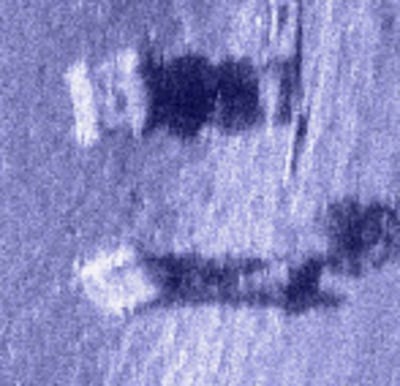On the water performance
When discussing locators, we’ve all heard the adage, “bigger is better”. Certainly, a larger screen will minimize eye strain as you study the Humminbird’s screen for information.
There was one circumstance where I felt that 1197’s larger screen presented a distinct advantage over the 997’s smaller screen: pulling cranks using the kicker. I run a tiller kicker (Yamaha T8), and I prefer to sit at the transom to run the motor (and easily monitor all 6 lines we normally pull), rather than sit at the helm and control the kicker remotely. Sitting at the transom separates me from the locator by 6-6.5 feet. With the 1197c in place, I could easily read the side imaging view from the transom, while I struggled to do so (without constantly hopping up and down to read the screen at the helm) with the 997c. When running the smaller 997c, I actually rigged up a second GPS/sonar combo right at the transom so I could avoid straining to see the 997c’s screen. No need to do so in the case of the 1197c. So, for the troller, the size of the 1197c presents a distinct advantage.
There are some other areas in which the 997c holds the advantage over the larger 1197c. First is that the 997 fits well into tight spaces. I have a full windshield on my boat, and the shorter 997c fits perfectly behind the screen. Due to its smaller size, I can adjust its position in a larger number of ways than I could the 1197c. In fact, there was exactly one way that the 1197c would fit behind my windscreen, and adjusting it from this position usually resulted in an odd viewing angle for either the screen or the operator.
Second, because the 1197c and the 997c have different numbers of vertical pixels (600 for the 1197, 480 for the 997) yet the same number of horizontal pixels (800 each), the units display information slightly differently and have different susceptibilities to the boat deviating from a straight path. Specifically, when using the 997c, I typically run a screen speed of 4 when moving at 4-5 mph, and can collect sharp images at trolling speed (currently about 1.8) at a screen speed of 2. To collect the same sharp images with the 1197c, I had to decrease my screen speed to 3 when operating at 4-5 mph, and all the way down to 1 at trolling speed. What this tells me is that each unit is likely displaying the same amount of “history” on the vertical axis, and doing do on the 1197c causes it to add new data more rapidly than does the 997c. As a result, to prevent images from being stretched out vertically on the 1197c, I had to slow the screen speed down relative to the more squat 997c. The apparently faster refresh rate of the 1197c (at a constant screen speed) is reflected in the amount of image blurring that occurs when deviating from a straight boat path. I tended to see more such blurring/distortion with the 1197c than I typically do with the 997c. My conclusion therefore is that images are smaller, yet perhaps sharper, with the 997c than with the 1197c. However, I also conclude that these issues can be overcome by paying attention to screen speed and boat direction, and that the larger screen size of the 1197c does indeed offer some distinct advantages.
















